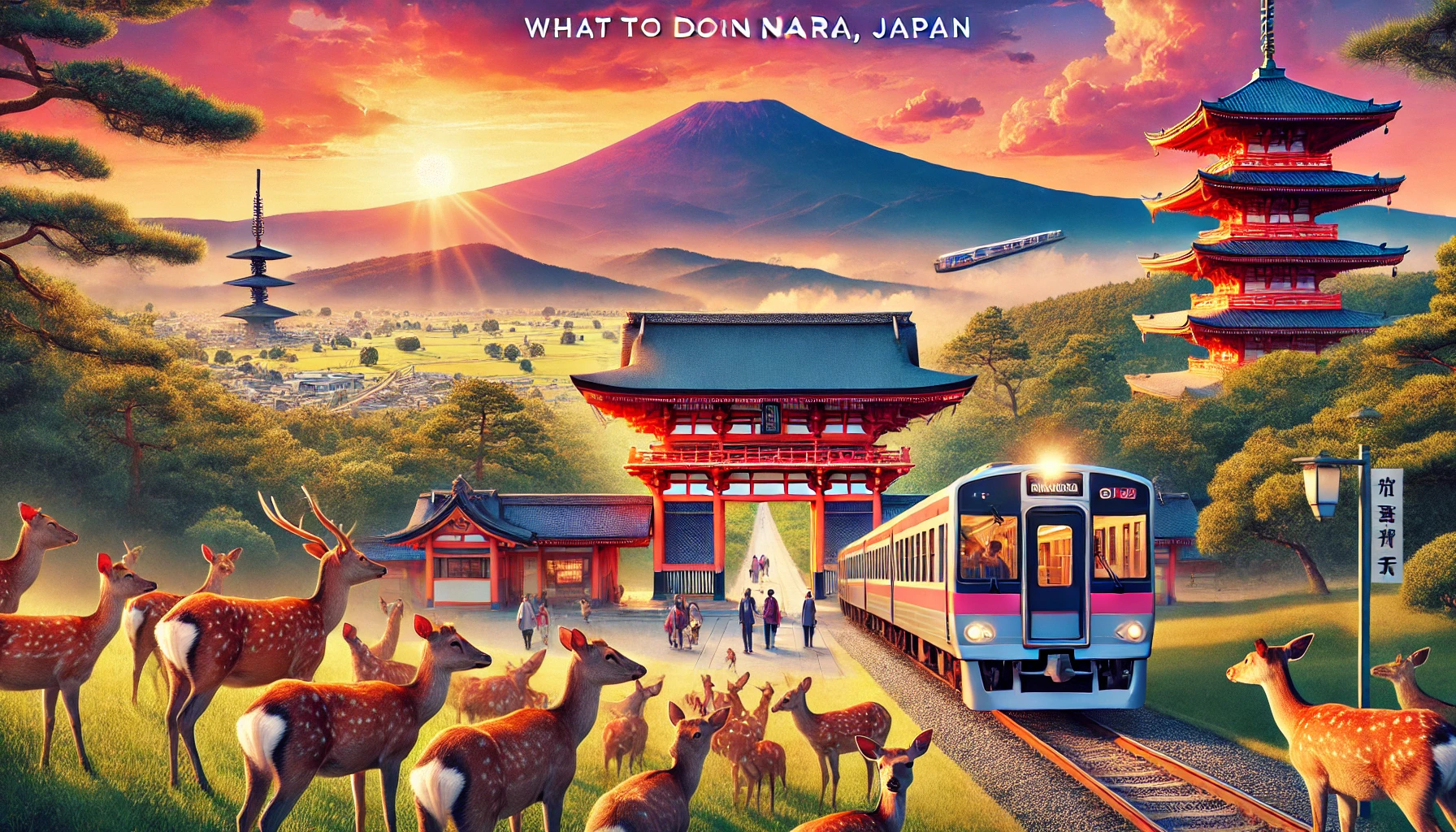What to Do in Nara, Japan (Historical Sites, Activities, food and shop)

Nara, Japan, is a remarkable destination filled with history, culture, and natural beauty. You can explore stunning temples, meet friendly deer in Nara Park, and enjoy local delicacies that highlight the region’s rich gastronomy. This ancient city, once Japan’s first permanent capital, offers a blend of urban and rural experiences that can cater to all interests.
Wandering through the vast Nara Park is a must, where you can interact with the famous free-roaming deer. Beyond the park, historical sites like Todai-ji Temple and Kasuga-taisha Shrine showcase Nara’s significance in Japanese history. You’ll also find plenty of shopping opportunities for unique souvenirs and local treats that perfectly capture the spirit of Nara.
As you plan your visit, consider the season, as each one offers its own charm and activities. Whether you’re a history buff, a nature enthusiast, or a foodie, Nara has something that will captivate your heart and mind during your stay.
Key Takeaways
- Nara Park is home to friendly deer and beautiful landscapes.
- Historical sites like Todai-ji offer a glimpse into Japan’s past.
- You can enjoy local food and shop for unique souvenirs in the city.
Exploring Nara Park

Nara Park offers a mix of beautiful scenery, friendly wildlife, and historic landmarks. As you roam this expansive green space, you’ll find the best routes to take, encounter free-roaming deer, and visit significant cultural sites.
Navigating the Best Routes
The best way to explore Nara Park is on foot or by bike. You can start at the entrance near Nara Station and follow well-marked paths. Look for signs directing you toward popular attractions. A loop around the park is about 2.5 kilometers, which takes approximately an hour to walk.
If you prefer cycling, consider renting a bike nearby. There are several bike rental stations. This method allows you to cover more ground quickly while enjoying the scenery. Be mindful of the deer along the paths, as they may cross your route unexpectedly.
Wildlife Encounters and Attractions
One of the highlights of Nara Park is its population of over 1,000 free-roaming deer. These deer are considered a national treasure. You can purchase special deer crackers called “shika-senbei” from vendors around the park. Feeding these friendly animals is a fun and memorable experience.
As you walk, you may also spot various birds and small animals. The park is a habitat for many species, providing an enjoyable experience for nature lovers. Don’t forget your camera, as the deer often pose for pictures, adding to your adventure in this incredible park.
Cultural Landmarks within the Park
Nara Park is home to significant cultural sites, including Todai-ji Temple and Kasuga-taisha Shrine. Todai-ji is famous for housing a giant bronze Buddha statue. The temple grounds have beautiful architecture and gardens worth exploring.
Kasuga-taisha Shrine is another must-see. The path leading to the shrine is lined with stone lanterns, creating a serene atmosphere. You can often find traditional ceremonies happening here. Both landmarks offer a glimpse into Japan’s rich history and spiritual heritage, making them essential stops during your visit.
Historical Sites in Nara
Nara is home to some of Japan’s most important historical sites. You can explore ancient temples, significant museums, and enjoy guided heritage walks to fully appreciate the city’s rich past.
Ancient Temples and Shrines
Nara is famous for its stunning ancient temples and shrines. One of the most notable is Todai-ji Temple, known for its Great Buddha statue. This temple shows impressive architecture, with a vast wooden building that houses the Great Buddha, a symbol of Nara.
Another important site is Kofuku-ji Temple. Founded in 669 CE, it was once a large complex with numerous structures, including a five-story pagoda. Walking through its grounds gives you a sense of the historical significance of this area.
You should also visit Kasuga-taisha, a Shinto shrine surrounded by beautiful gardens and wildlife. The hundreds of stone and bronze lanterns here create a serene atmosphere that reflects Japan’s spiritual heritage.
The Nara National Museum
The Nara National Museum offers a deep dive into Japanese art and history. Its collection focuses on Buddhist art, showcasing various sculptures, paintings, and artifacts.
You can explore exhibits that detail the history of Nara as Japan’s ancient capital. The museum does an excellent job of presenting the evolution of art over centuries.
Additionally, the museum often hosts special exhibitions. These displays present various aspects of Japanese culture and history, making each visit unique.
Heritage Walks and Tours
Heritage walks and tours are a fantastic way to experience Nara’s historical sites. Many guided tours will take you through Nara Park, where you can see deer roaming freely among ancient temples.
You can also explore UNESCO World Heritage sites, which tell the story of Nara’s significance during Japan’s history. Walking through the streets allows you to appreciate the beautiful blend of nature and culture.
Using these guided experiences, you can gain insight into the stories behind the landmarks. Engaging with knowledgeable guides will enhance your understanding of Nara’s rich heritage.
Recreational Activities
Nara offers a variety of recreational activities that cater to different interests. From vibrant seasonal events to engaging outdoor experiences, you can enjoy the rich culture and natural beauty of this historical city.
Seasonal Events and Festivals
Nara hosts numerous seasonal events and festivals throughout the year. These activities reflect its rich history and culture, making them essential experiences for visitors.
In spring, the Nara Yamayaki festival takes place in January, where locals burn grass on Mt. Wakakusa to celebrate the New Year. The Nara Tōkae Festival, held in August, features thousands of lanterns illuminating Nara Park, creating a magical atmosphere.
In autumn, the Kasuga-taisha Shrine has special rituals that attract many visitors. Shin-Yamaguchi Tanabata Matsuri in July showcases colorful bamboo decorations, encouraging visitors to write their wishes on strips of paper. Participating in these events immerses you in Nara’s unique traditions.
Outdoor Activities and Experiences
Nara is perfect for outdoor enthusiasts. The city is surrounded by beautiful parks and mountains.
Nara Park is famous for its free-roaming deer, allowing you to interact with these gentle animals. You can stroll through the park while enjoying beautiful cherry blossoms in spring or vibrant autumn colors.
Hiking on Mt. Wakakusa offers stunning views of the city and surrounding nature. There are marked trails suitable for all skill levels. Cycling is another great way to explore; you can rent bikes and ride through scenic areas.
Visiting Kasuga-taisha Shrine also presents the option to hike along the picturesque trails leading to the shrine. These outdoor experiences make Nara an exciting destination for nature lovers and adventurers alike.
Gastronomy
Nara offers a rich culinary experience that reflects its history and local ingredients. You can explore traditional dishes and enjoy unique dining options throughout the city. Sake breweries also provide a fascinating insight into local brewing techniques.
Local Cuisine and Dining Options
In Nara, you can taste traditional dishes that highlight local flavors. One must-try dish is kamameshi, a rice dish cooked in a cast iron pot. You can find spots like Kamameshi Shizuka Kouen-ten that offer specialties such as Nara-nanashu Kamameshi, featuring shrimp and native chicken.
Another local favorite is kakinohazushi, sushi wrapped in persimmon leaves, available at local restaurants near Kinpusen-ji Temple. You might also enjoy narazuke pickles, made by marinating vegetables in sake lees, a practice that dates back to the 700s.
If you prefer noodles, many establishments serve soba, showcasing regional flavors. Dining in Nara is a journey through diverse tastes, from traditional Japanese dishes to modern gourmet options.
Sake Breweries and Tasting Tours
Nara is known for its high-quality sake, produced using ancient techniques and local rice. Visiting one of Nara’s sake breweries lets you learn about the brewing process firsthand. Many breweries offer tasting tours where you can sample various types of sake.
You can enjoy guided tours that explain the history and methods of sake production. Some breweries, such as those mentioned in local travel guides, have stunning settings that enhance the experience. Take the opportunity to purchase your favorite bottles to enjoy later.
This experience not only delights your palate but also deepens your appreciation for Japanese culture. Sake tasting in Nara should definitely be on your itinerary.
Planning Your Visit
When planning your visit to Nara, consider your accommodation options and how you’ll get around the city. Nara is accessible and offers various places to stay, along with convenient transportation options for exploring its attractions.
Accommodation Choices
Nara has a range of accommodation options to fit different budgets. For a unique experience, consider staying at traditional ryokans, which offer tatami-matted rooms and Japanese cuisine. Some popular choices include Onyado Nono Nara Natural Hot Spring, known for its beautiful design and close proximity to the city center.
If you’re looking for something budget-friendly, the Nara Visitor Center and Inn is centrally located. It’s only a short walk from major attractions like Kofuku-ji Temple and Naramachi. Additionally, there are several hotels and guesthouses available, giving you flexibility in your stay.
Transportation and Accessibility
Getting to Nara from Kyoto is straightforward. The Express Kintetsu trains provide a quick ride, taking about 43 to 50 minutes and costing around ¥620. If you have a Japan Rail Pass, you can use the Miyakoji or Yamatoji trains from Osaka and Kyoto, making it convenient for day trips.
Once in Nara, public transportation is available, but many sites are within walking distance. This makes it easy to explore, especially the famed Nara Deer Park and Todai-ji Temple. Make sure to wear comfortable shoes for walking and enjoy the beautiful scenery along the way.
Shopping and Souvenirs
Nara offers a blend of traditional crafts and modern shopping experiences. You will find unique souvenirs that reflect the region’s rich culture, as well as contemporary shopping areas for a more urban feel.
Traditional Crafts and Specialties
Nara is famous for its traditional crafts, which make excellent souvenirs. The area is known for beautiful ceramics, lacquerware, and textiles. You can visit shops along streets like Mochiidono Center Gai, where you will find skilled artisans displaying their work.
A popular item is Nara’s soy sauce, which has been made by the same family for over 150 years. The carefully packaged smaller bottles are perfect for taking home.
Another unique souvenir is washi paper, a traditional Japanese handmade paper. Look for items such as notebooks or decorative sheets. You can also spot charming deer-themed products inspired by the famous Nara deer, from plush toys to keychains.
Modern Shopping Centers
For a different shopping experience, explore Nara’s modern shopping areas. Sanjo Dori is one of the main streets where you will find a variety of stores ranging from popular retail outlets to local shops.
In the Mochiidono Centre Town, check out the Nara Kuta Shop. This store started with character-themed products but now offers a diverse range of items.
You can also visit larger shopping centers that feature international brands, electronics, and more. Many stores are open late, making it easier to shop at your convenience.
Whether you’re looking for traditional items or modern goods, Nara has something for everyone.






